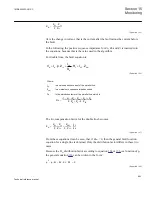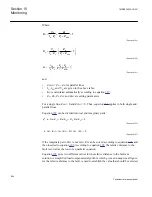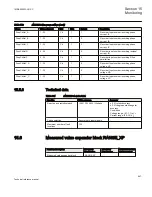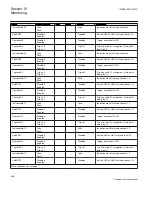
Manual trigger
A disturbance report can be manually triggered from the local HMI, PCM600 or via
station bus (IEC 61850). When the trigger is activated, the manual trigger signal is
generated. This feature is especially useful for testing. Refer to the operator's manual
for procedure.
Binary-signal trigger
Any binary signal state (logic one or a logic zero) can be selected to generate a trigger
(
Triglevel
= Trig on 0/Trig on 1). When a binary signal is selected to generate a trigger
from a logic zero, the selected signal will not be listed in the indications list of the
disturbance report.
Analog-signal trigger
All analog signals are available for trigger purposes, no matter if they are recorded in
the disturbance recorder or not. The settings are
OverTrigOp
,
UnderTrigOp
,
OverTrigLe
and
UnderTrigLe
.
The check of the trigger condition is based on peak-to-peak values. When this is found,
the absolute average value of these two peak values is calculated. If the average value
is above the threshold level for an overvoltage or overcurrent trigger, this trigger is
indicated with a greater than (>) sign with the user-defined name.
If the average value is below the set threshold level for an undervoltage or undercurrent
trigger, this trigger is indicated with a less than (<) sign with its name. The procedure
is separately performed for each channel.
This method of checking the analog trigger conditions gives a function which is
insensitive to DC offset in the signal. The operate time for this initiation is typically in
the range of one cycle, 16 2/3 ms for a 60 Hz network.
All under/over trig signal information is available on the local HMI and PCM600.
Post Retrigger
Disturbance report function does not automatically respond to any new trig condition
during a recording, after all signals set as trigger signals have been reset. However,
under certain circumstances the fault condition may reoccur during the post-fault
recording, for instance by automatic reclosing to a still faulty power line.
In order to capture the new disturbance it is possible to allow retriggering (
PostRetrig
=
Enabled
) during the post-fault time. In this case a new, complete recording will start
and, during a period, run in parallel with the initial recording.
When the retrig parameter is disabled (
PostRetrig
=
Disabled
), a new recording will
not start until the post-fault (
PostFaultrecT
or
TimeLimit
) period is terminated. If a
new trig occurs during the post-fault period and lasts longer than the proceeding
recording a new complete recording will be started.
1MRK505222-UUS C
Section 15
Monitoring
957
Technical reference manual
Summary of Contents for Relion 670 series
Page 1: ...Relion 670 series Line differential protection RED670 ANSI Technical reference manual...
Page 2: ......
Page 40: ...34...
Page 50: ...44...
Page 60: ...54...
Page 126: ...120...
Page 384: ...378...
Page 496: ...490...
Page 556: ...550...
Page 602: ...596...
Page 620: ...614...
Page 794: ...788...
Page 864: ...858...
Page 988: ...982...
Page 998: ...992...
Page 1084: ...1078...
Page 1164: ...1158...
Page 1168: ...1162...
Page 1220: ...1214...
Page 1230: ...1224...
Page 1231: ...1225...
















































